How to Read and Understand Ingredient Lists (South African Guide)
Ever looked at a product label and wondered why a simple ingredient like water becomes Aqua, and shea butter suddenly turns into Butyrospermum Parkii Butter? Welcome to the world of INCI, the secret language of cosmetics.
If you're building a skincare or beauty brand in South Africa, understanding INCI is essential. It protects your business, builds trust with your customers, and keeps your products legally compliant.
This guide breaks down INCI in a way that’s easy to understand, with a little personality and real brand insight along the way.

What Is INCI?
INCI stands for International Nomenclature of Cosmetic Ingredients. It’s a standard system for naming cosmetic ingredients. No marketing fluff - only correct, universal names.
Why it exists:
- Prevents confusing ingredient names
- Helps consumers identify allergens
- Makes products legally compliant
- Keeps your brand export-ready
In South Africa, using INCI is part of cosmetic labelling standards set by the CTFA and NRCS, so if you’re selling cosmetic products, INCI isn’t optional.

How to Read an INCI Ingredient List
INCI lists may look like chemistry exams, but once you know the rules, they're easy to read.
Rule 1: Ingredients are listed by amount
Listed from highest to lowest concentration.
Example: Aqua, Glycerin, Caprylic/Capric Triglyceride, Niacinamide, Carbomer, Phenoxyethanol, Parfum
Water is used the most, fragrance the least.
Rule 2: The “1% rule”
After 1% concentration, ingredients can be listed in any order. Preservatives, fragrances and colourants often fall below 1%.
Rule 3: Plant ingredients = Latin names
Botanical names come first, followed by the plant part or oil type.
| Common Name | INCI Name |
|---|---|
| Lavender Oil | Lavandula Angustifolia Oil |
| Rosehip Oil | Rosa Canina Seed Oil |
| Aloe Vera | Aloe Barbadensis Leaf Juice |
Rule 4: Fragrances and colours have special labels
- Fragrance is listed as Parfum or Aroma
- Colourants are listed with CI numbers
e.g. CI 77491 = Iron Oxide (red), CI 77891 = Titanium Dioxide
INCI vs Common Names
| Common Name | INCI Name |
|---|---|
| Water | Aqua |
| Vitamin E | Tocopherol |
| Shea Butter | Butyrospermum Parkii Butter |
| Olive Oil | Olea Europaea Fruit Oil |
| Glycerine | Glycerin |
| Lavender Oil | Lavandula Angustifolia Oil |
- You may NOT use ingredient names like “Glow Oil Base” or “Hydrating Boost”.
- You MUST use INCI names.
Why Some INCI Names Look “Chemical”
Not everything that sounds chemical is harmful. Some are skin-friendly and safe.
| INCI Name | What It Really Is |
|---|---|
| Sodium Hyaluronate | Hyaluronic Acid |
| Cetyl Alcohol | Emollient (not drying) |
| Caprylic/Capric Triglyceride | Coconut-derived moisturiser |
| Xanthan Gum | Thickener from plants |
Even water can sound scary in chemical terms: Dihydrogen Monoxide. So don’t judge an ingredient by how it sounds.

Understanding Allergens in INCI Lists
Allergens are naturally occurring compounds found in essential oils and fragrances that can cause irritation or sensitivity in some people. Even though they aren’t added separately, they must be listed on your INCI label if they’re present above a certain amount.
Common examples include Limonene, Linalool, Citral, Geraniol, and Coumarin — often found in oils like lavender, citrus, and geranium.
Including them on your label doesn’t mean your product is unsafe; it simply shows transparency and helps customers with sensitive skin make informed choices. In South Africa, following this rule aligns your labels with both local CTFA and international EU cosmetic standards.
SA Labelling Checklist for INCI
To stay safe and compliant:
- Use INCI names only
- List ingredients in descending order
- Include allergens if applicable
- Add CI numbers for colourants
- Avoid misleading terms like “chemical-free”
- Keep ingredient names accurate and transparent
Final Thoughts
INCI isn’t just a labelling rule, it’s professionalism in action. When your ingredient list is honest, organised and compliant, you build trust. And trust is what turns first-time buyers into loyal customers.



